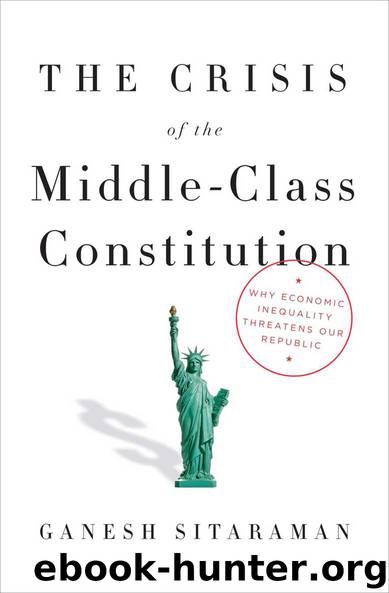The Crisis of the Middle-Class Constitution: Why Economic Inequality Threatens Our Republic by Sitaraman Ganesh

Author:Sitaraman, Ganesh [Sitaraman, Ganesh]
Language: eng
Format: epub, azw3
ISBN: 9780451493910
Publisher: Knopf Doubleday Publishing Group
Published: 2017-03-13T21:00:00+00:00
THE GLORIOUS YEARS
The New Deal and World War II ushered in an era of middle-class growth and economic equality, which economists Claudia Goldin and Robert Margo have called “the great compression.”236 Over the next generation, America experienced an economic boom whose benefits were broadly shared. Between 1948 and 1978, American productivity (measured by GDP) rose by 107.8 percent.237 During that same period, the median male worker’s income continually rose, tracking GDP closely; by 1978, hourly compensation was up 96 percent.238 Shared growth and prosperity meant a stronger middle class on metrics other than wages. In 1940, 43.6 percent of Americans were homeowners. With the postwar boom, that number had hit 64.4 percent by 1980.239
To be sure, the wealthiest Americans did better than those in the middle class. But their share of America’s wealth was nowhere near as large as it had been in the decades before the Depression. In 1928, at the height of the Roaring Twenties, the top 10 percent of Americans took home 46 percent of the country’s income excluding capital gains and 49 percent including capital gains. Between 1951 and 1982, the top 10 percent share never hit 33 percent excluding capital gains and never reached 35 percent including capital gains.240 The top 0.1 percent of Americans in the late 1920s had 25 percent of the nation’s wealth. By 1950, their share was down to about 10 percent, and it hovered there or below until the 1980s.241 At the other end of the spectrum, shared prosperity and government policy meant that the poverty rate dropped precipitously in the postwar years, reaching a low point of 11.1 percent in 1973.242 In other words, whether we look at the median worker, the wealthiest Americans, or the number of Americans in poverty, economic inequality was becoming less of a problem in the rising tide era after World War II.
Government policies were critical to building the middle class and growing a middle-class economy. The GI Bill, for example, sent 2.2 million veterans to college, and it provided many veterans with loans to start small businesses and buy new homes. Between World War II and 1966, one-fifth of all homes built in the United States were financed through the GI Bill.243 The bill cost $7 billion, but for every dollar invested, between $5 and $12 were returned over thirty-five years in higher productivity and tax revenues.244 President Dwight D. Eisenhower’s massive interstate highway system—which at the time was projected to cost $25 billion—was partly intended to serve as a public works project, which Eisenhower hoped would put millions of people to work and smooth out the peaks and valleys in unemployment.245 Estimates are that highway spending was responsible for 31 percent of yearly productivity growth in the late 1950s and 25 percent of yearly productivity growth in the 1960s.246
Federal policies also reined in the financial sector and the economic gains and power of the wealthy. From the founding of the country until the Great Depression, the United States saw financial panics and crises roughly every twenty years—1819, 1837, 1857, 1873, 1893, 1907, 1929.
Download
The Crisis of the Middle-Class Constitution: Why Economic Inequality Threatens Our Republic by Sitaraman Ganesh.azw3
This site does not store any files on its server. We only index and link to content provided by other sites. Please contact the content providers to delete copyright contents if any and email us, we'll remove relevant links or contents immediately.
| Africa | Americas |
| Arctic & Antarctica | Asia |
| Australia & Oceania | Europe |
| Middle East | Russia |
| United States | World |
| Ancient Civilizations | Military |
| Historical Study & Educational Resources |
Cat's cradle by Kurt Vonnegut(14782)
Pimp by Iceberg Slim(13803)
Underground: A Human History of the Worlds Beneath Our Feet by Will Hunt(11846)
4 3 2 1: A Novel by Paul Auster(11817)
The Radium Girls by Kate Moore(11639)
Wiseguy by Nicholas Pileggi(5332)
American History Stories, Volume III (Yesterday's Classics) by Pratt Mara L(5141)
Perfect Rhythm by Jae(5080)
The Fire Next Time by James Baldwin(5032)
Paper Towns by Green John(4811)
Pale Blue Dot by Carl Sagan(4630)
A Higher Loyalty: Truth, Lies, and Leadership by James Comey(4564)
The Mayflower and the Pilgrims' New World by Nathaniel Philbrick(4286)
The Doomsday Machine by Daniel Ellsberg(4253)
Killers of the Flower Moon: The Osage Murders and the Birth of the FBI by David Grann(4195)
Too Much and Not the Mood by Durga Chew-Bose(4103)
The Sympathizer by Viet Thanh Nguyen(4098)
The Borden Murders by Sarah Miller(4031)
Sticky Fingers by Joe Hagan(3916)
